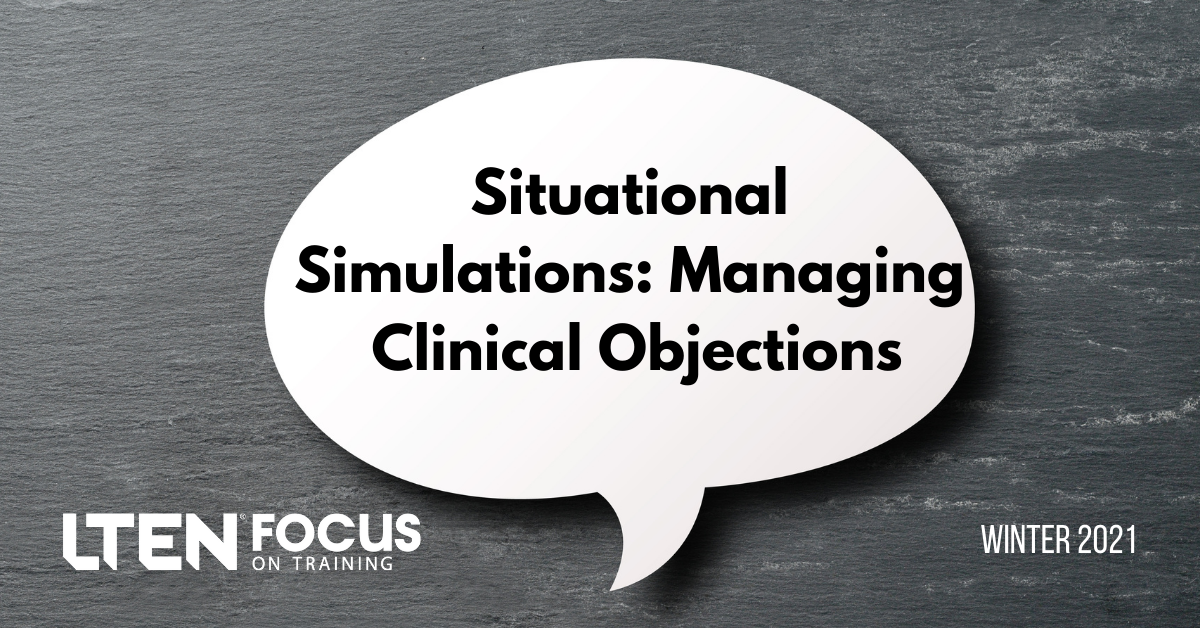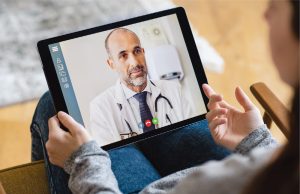
Situational Simulations: Managing Clinician Objections
FEATURE STORY – By Brian R. Stahl, BSN, RN, CRNI, PLNC
Challenges can be assessed using four fundamental questions.
As a medical device trainer, one of my responsibilities is to teach field representatives how to assess and solve clinician product challenges during an evaluation and after the sale. I do this using a role play or, as I’ve come to call them, a situational simulation (or “SitSim” for short).
Over the years I’ve collected examples of common clinician challenges, as well as responses to those challenges. Over time I noticed patterns. Often the challenges could be assessed using one or more of four fundamental questions:
- Can you show me?
- Are you having success?
- How many times have you used our device?
- Were you able to attend the product training event?
When properly applied, these four questions frequently get to the root of most clinicians’ objections and permit your rep to respond efficiently and effectively. The purpose of this article is to share more about these four questions and encourage you to teach them in SitSim during your training as well.
Question #1: “Can You Show Me?”
This is the most used question of the four. However, this question is only effective if the clinician has a specific issue when using the device such as: “I’m having issues with ___” or, “When I use this device it always___.”
A clinician’s muscle memory, or habits, of using the prior device often has a significant impact on their technique when using a new device. By asking the clinician to show you and providing an opportunity to demonstrate the use of the new device on a simulation model, the rep is able to identify subconscious habits that worked with the prior device but are negatively affecting the clinician’s successful use and/or perception of the new device.
 Having spotted an issue during the clinician demonstration, the rep should next ask, “Can I show you?” The rep would then demonstrate the correct use of the new device, pointing out specific areas where the clinician had challenges and explaining any possible changes in technique to improve its successful use. Finally, the rep should ask, “Can you show me again?” and allow the clinician to demonstrate back the new action(s) to assess and confirm understanding and application.
Having spotted an issue during the clinician demonstration, the rep should next ask, “Can I show you?” The rep would then demonstrate the correct use of the new device, pointing out specific areas where the clinician had challenges and explaining any possible changes in technique to improve its successful use. Finally, the rep should ask, “Can you show me again?” and allow the clinician to demonstrate back the new action(s) to assess and confirm understanding and application.
“Can you show me?” will not be effective if the clinician is speaking on behalf of another person or repeating objections they’ve heard as hearsay. However, hearsay objections can be uncovered. When asked, “Can you show me?” the person who has not experienced the challenge will generally deflect or admit that they had only heard about it. In these cases, follow up to locate and address the origin of the objection and address it with the correct person.
Often a clinician objection is an expression that is more emotional, an opinion or a feeling. For example: “Your device is too small,” or, “I don’t like your product!” Clearly following statements like these with, “Can you show me?” is not the best response. At least not yet. (I say “yet” because there are those occasions when the clinician’s feeling or opinion may later lead to a specific practice issue.)
Question #2: “Are You Having Success?”
When a clinician’s objection is expressed as a feeling or opinion, a good question to use is, “Are you having success?” This is a deliberately closed-ended question to illicit a “yes” or “no” response.
 If “yes” then the rep can focus on being primarily an empathetic listener and encourager while congratulating the person on their successes and adaptability to change. If the answer is “no,” your rep knows there is possibly a deeper issue to address and can follow up with the question, “What specifically is keeping you from being successful?”
If “yes” then the rep can focus on being primarily an empathetic listener and encourager while congratulating the person on their successes and adaptability to change. If the answer is “no,” your rep knows there is possibly a deeper issue to address and can follow up with the question, “What specifically is keeping you from being successful?”
When informed of a specific issue, your employee can now engage with, “Can you show me?” to move the troubleshooting process along effectively.
Question #3: “How Many Times Have You Used Our Device?”
The third question is intended to provide a quick assessment of the clinician’s progress through the device change process. Prior techniques and associated habits established from using another device can be challenging to overcome. By asking this question, the rep can gain valuable insight into a number of factors causing a clinician’s struggles.
Most notably, the time between initial training and the number of uses provides an estimate of frequency of use. This insight helps guide the troubleshooting conversation and set realistic expectations around the clinician’s product use: successful-outcomes ratio (i.e., practice makes perfect).
Question #4: “Were You Able to Attend Product Training?”
The final question, about product training, is another closed-ended question to assist the rep in quickly understanding the amount of support likely needed as they proceed. An important consideration in the use of this question is the timing of when it is asked. It should be employed early in the troubleshooting process to avoid risking offense to the clinician.
Imagine asking, “Were you able to attend product training?” after the clinician has demonstrated their technique. This question, asked at that point in time, could be interpreted as a judgment of their skills (which may be deserved but still should not be implied by using this question). However, when asked winsomely, as part of the initial conversation, this can help set the cooperative framework needed to resolve challenges.
A response of “yes” allows the rep to refer back to the prior training and remind and reinforce details. A response of “no” allows the rep to acknowledge a need for more detailed training and to take the necessary steps to complete it in a timely manner.
Conclusion
The order in which these questions are used is dependent on what manner the clinician presents to the rep. Often all four questions will be asked while addressing the clinician’s concern. Occasionally, only one question will be needed. When that is the case it is most often, “Can you show me?”
By creating a safe SitSim environment, trainees are encouraged to experiment and practice objection handling in class. By leveraging group discussion and formative debriefs within the SitSim, reps begin to understand the effective application of these questioning techniques. They become better prepared to manage clinician objections efficiently and effectively in their roles in the field.
Brian R. Stahl, BSN, RN, CRNI, PLNC, is associate director, sales training & clinical education for B. Braun Medical. Email Brian at brian.stahl@bbraunusa.com.








